Arizona’s dark skies are spectacular, offering a rare glimpse into the cosmos. You’ve likely heard about the state’s stellar night views and are eager to experience this celestial splendor.
However, finding the best spots for stargazing in Arizona can be challenging. Knowing where to start is hard, with so many locations boasting dark skies. Balancing your desire for starry skies with practical travel planning adds complexity.
I’ll guide you through Arizona’s top dark sky locations in this article. You’ll learn where to go and how to make the most of your stargazing journey. From Dark Sky Parks to urban programs, I’ve got all the insider tips to ensure your starlit adventure is truly out of this world.
Key Things To Know:
- Best Dark Sky Locations: Discover Arizona’s top spots, like the Grand Canyon and Oracle State Park, for unparalleled stargazing.
- Benefits of Dark Skies: Learn how clear skies enhance stargazing, support ecosystems, and save energy.
- Dark Sky Preservation: Explore how Arizona’s communities, like Flagstaff and Sedona, are leading in dark sky conservation.
- Stargazing Resources: Find out about tools and apps to enhance your night sky experience in Arizona.
Recommended For You
Overview of Arizona Dark Sky Map Locations

Arizona is a stargazer’s dream, with clear night sky views unfettered by city lights. During my visits, I’ve been awed by the clarity and beauty of the night skies here. It’s even possible to go Stargazing in Phoenix!
You can visit places where the stars shine bright and galaxies reveal themselves in the darkness. These spots are known for their dark skies and efforts to keep night skies natural and free of light pollution.
- Dark Sky Parks: These are nature’s own theaters for viewing the cosmos. Each visit has deepened my appreciation for these pristine stargazing locations. Arizona boasts several of these, where you can gaze at constellations, planets, and shooting stars.
- International Dark Sky Places: Certified by a group focused on dark sky preservation, these places meet strict guidelines for keeping skies dark.
Arizona has a mix of Dark Sky Parks and Dark Sky Communities. Parks are primarily outside cities, while communities are places where people live and work under protected night skies.
Here’s a quick list:
- Parks: Enjoy natural landscapes and night skies together.
- Communities: Whole towns dedicated to reducing light pollution.
From my experiences, Arizona leads with exceptional examples of dark sky preservation, offering breathtaking views of the night sky even without a telescope.
Read my article about the best stargazing in Arizona.
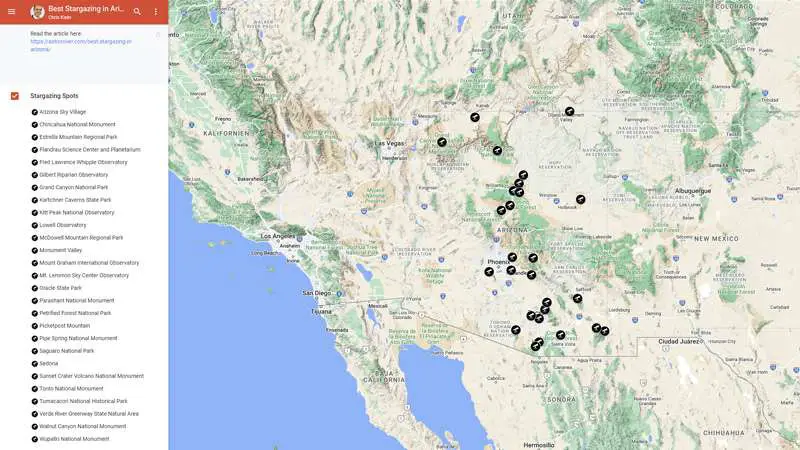
FREE STARGAZING CHECKLIST
My 5-page Stargazing Checklist will enhance your astronomical observations.
Follow this free checklist to navigate the night sky with confidence, clarity, and a sense of preparedness for a rewarding stargazing experience.

Benefits of Dark Skies
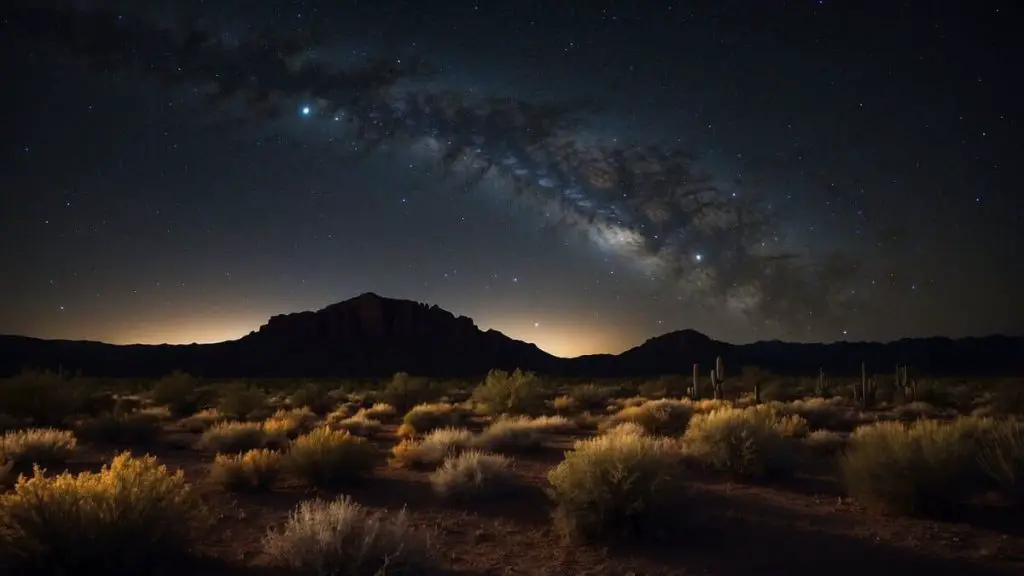
You’re in for a treat when you look up at a night sky free from light pollution. Dark skies let you see the stars and the Milky Way as nature intended. It’s a natural scene that too many people miss out on.
Here are some perks of having dark skies:
- Better Stargazing: Without bright lights, celestial objects like stars and planets pop out. This is like a dream come true for astronomers and members of an astronomy club. This enhanced visibility has made each of my stargazing sessions in Arizona unforgettable.
- Healthy Ecosystems: Animals and plants rely on dark periods for natural rhythms. Light pollution can throw off these cycles. In a dark sky environment, you help keep natural patterns in balance.
- Saving Energy: Using fewer lights for the sake of dark skies means less electricity used. That’s a win for your wallet and the planet.
- Science and Education: Observing the night sky can teach us a lot. Scientists and students can learn and discover more about our universe with clear views.
- Enjoyment of Natural Beauty: Consider how calming a clear, dark night can be. You can see the dance of starlight and delicate shadows that you can’t see anywhere else.
Remember, each dark spot on a map promises a clear view of the stars. So find a dark sky place near you and experience these benefits yourself.
Notable Dark Sky Parks and Monuments
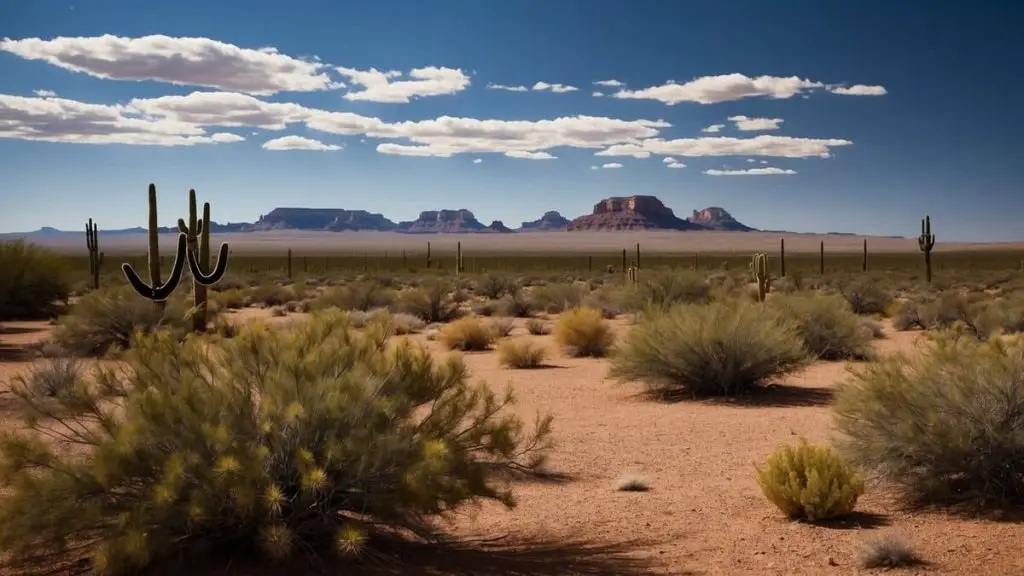
Arizona has an impressive array of Dark Sky Parks and Monuments where you can enjoy night skies with minimal light pollution. Let’s explore some of the prime locations in the state.
Grand Canyon National Park
The Grand Canyon National Park is not just a breathtaking natural wonder during the day. At night, the sky above the canyon lights up with millions of stars.
Read my article about the best stargazing in Grand Canyon National Park.
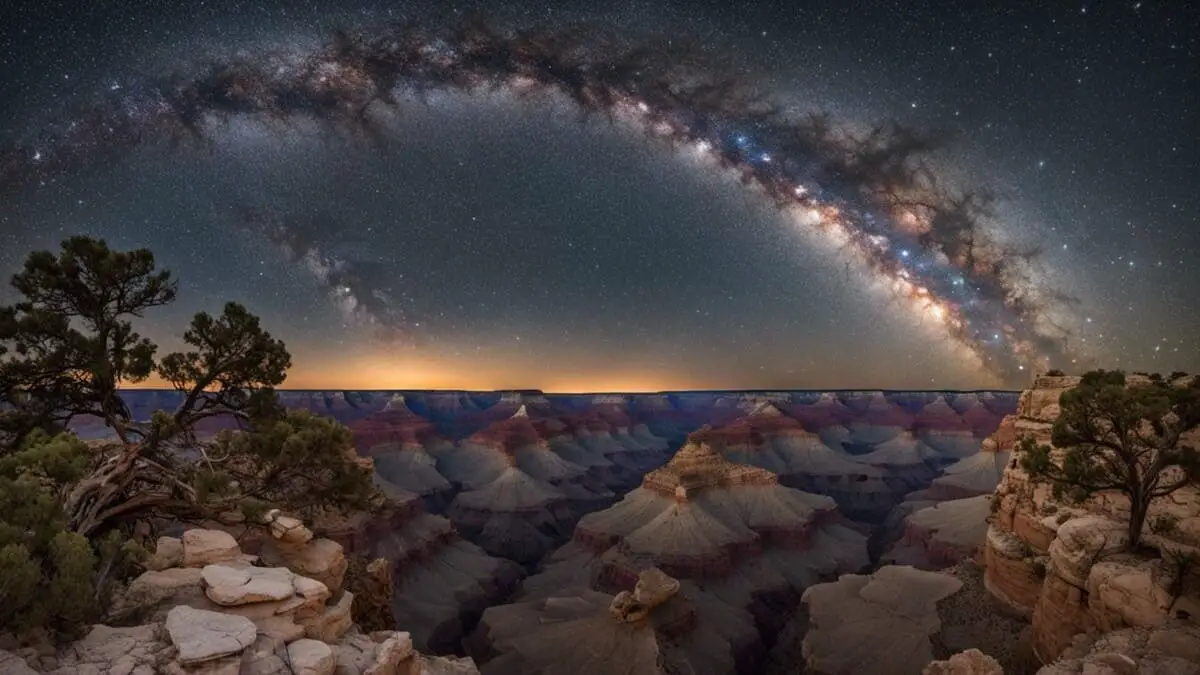
Kartchner Caverns State Park
Kartchner Caverns State Park offers a dark sky experience that complements the underground marvels you can explore during the day.
Oracle State Park
At Oracle State Park, the sky becomes a canvas for stargazing and contemplation thanks to its official designation as a Dark Sky Park.
Read my article about the best stargazing in Oracle State Park.

Petrified Forest National Park
The Petrified Forest National Park is as stunning under the night sky as the sun, with ancient logs looking otherworldly beneath the stars.
Chiricahua National Monument
Experience the Milky Way in all its glory at the Chiricahua National Monument, where night skies are as dramatic as the landscape.
Pipe Spring National Monument
Pipe Spring National Monument offers a historical experience and an excellent place to gaze at the night sky.
Saguaro National Park
The iconic cacti at Saguaro National Park stand tall against dazzling stars and clear, dark skies.
Walnut Canyon National Monument
At Walnut Canyon National Monument, you can enjoy the star-filled sky peering into the canyon’s depth.
Wupatki National Monument
Join the stars at Wupatki National Monument, where you’ll find silence and a sky teeming with celestial bodies.
Sunset Crater Volcano National Monument
Finally, take advantage of the impressive dark skies at Sunset Crater Volcano National Monument, where the landscape feels as timeless as the constellations above.
Urban and Community Dark Sky Programs
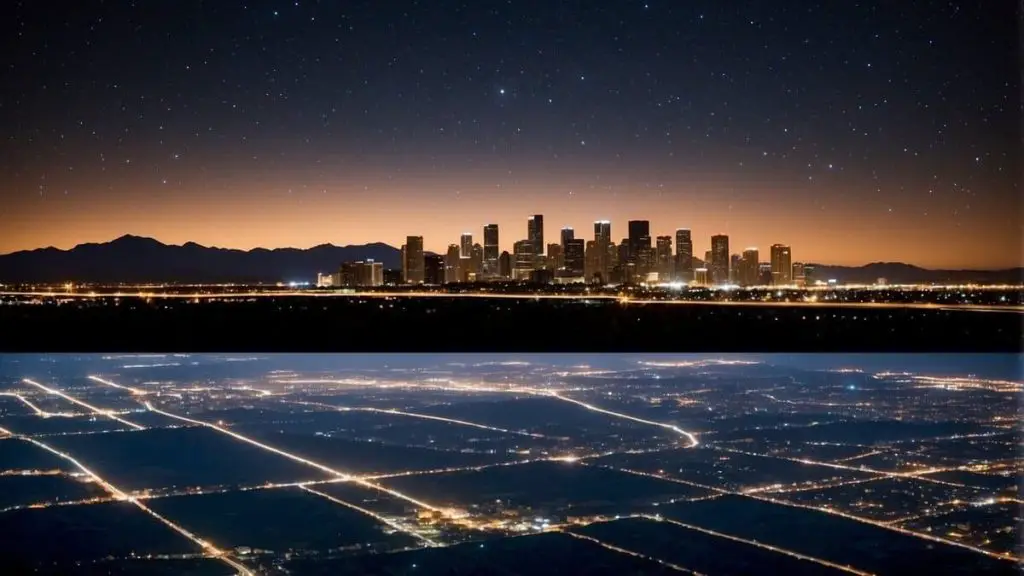
Arizona is known for its clear skies, making it perfect for stargazing. To ensure these views stay pristine, certain areas in the state are recognized for their commitment to preserving the night sky through smart lighting and public outreach.
Flagstaff Dark Sky City
Flagstaff was the first city in the world to be designated a Dark Sky City.
Here’s what you should know:
- Flagstaff is committed to preserving its dark skies. The city has had responsible lighting policies in place for over six decades.
- These efforts mean you can enjoy breathtaking starry nights.
Fountain Hills Dark Sky Community
Not too far from the bustling city life, Fountain Hills offers an escape for stargazers.
- They’ve been officially named a Dark Sky Community because of their dedication to dark sky conservation.
- Public education is considerable here; they want to ensure everyone knows how to keep the sky dark and full of stars.
Sedona Dark Sky Community
The vibrant red rock city of Sedona isn’t only famous for its stunning landscapes.
- It’s also a certified Dark Sky Community, taking care to control light pollution.
- As I’ve experienced in Sedona, you can marvel at the Milky Way with ease, a testament to their commitment to the dark sky movement.
Read my article about the best stargazing in Sedona.
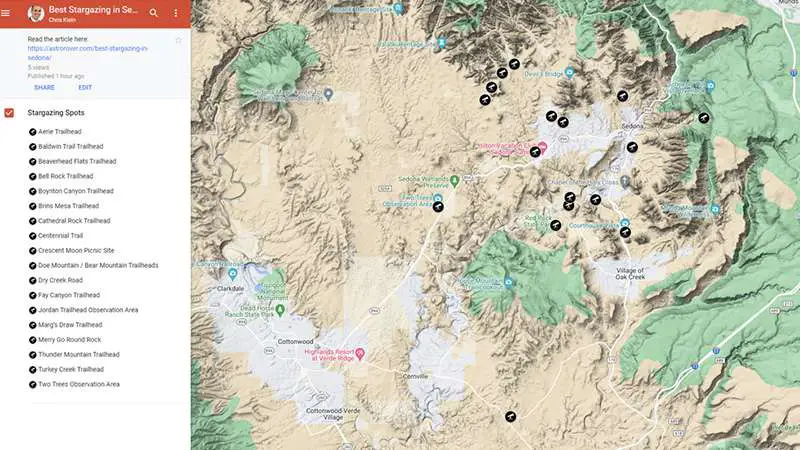
Events and Education
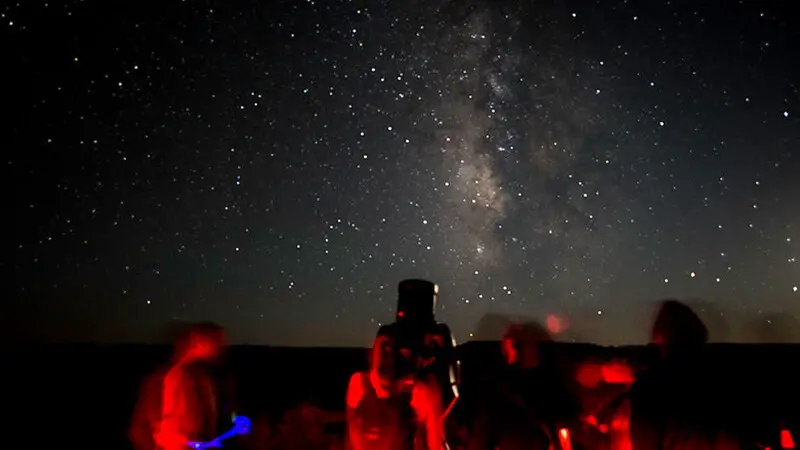
Arizona’s dark skies offer more than just a visual treat; they provide a gateway to learning and community engagement. Through special events, local clubs, and top-notch observatories, you get to dive deep into astronomy, no matter your level of expertise.
Star Parties and Events
- Participate in Public Stargazing: Having joined several star parties, I can confirm they let you enjoy Arizona’s clear night skies with fellow space enthusiasts. Check out events like those at Kitt Peak National Observatory, where you can gaze at the stars through high-quality telescopes.
- Join the Community: Often free, these gatherings typically include educational talks, telescope viewings, and guidance from experienced astronomers.
Astronomy Clubs and Outreach
- Connect with Local Clubs: Astronomy clubs in Arizona are active and welcoming, offering workshops, speaker events, and public education. You’ll find friends and mentors to help you explore the skies.
- Expand Your Knowledge: Look for clubs like those associated with the Giovale Open Deck Observatory at Lowell Observatory, offering both learning opportunities and social events.
Educational Facilities and Observatories
- Visit World-Renowned Observatories: Facilities like Lowell Observatory and Fred Lawrence Whipple Observatory are open for learning and observing. Take guided tours, attend special lectures, and use advanced telescopes under dark skies. Observing through their powerful telescopes has been an eye-opening experience for me.
- Learn from Experts: Observatories often have programs for all ages. For example, Mount Lemmon Sky Center has renowned astronomers to guide you. You can learn to identify constellations, understand celestial mechanics, and more.
Stargazing Resources

You want to enjoy the night sky in Arizona, right? I’ve got you covered. Below, you’ll find resources to help you spot stars, planets, and more. Let’s dive in.
Guides and Charts
- Bortle Scale Maps: To see the stars better, look for spots with low light pollution using Bortle scale maps. The darker the area, the clearer the night sky.
- Star Charts: Grab a star chart to identify constellations, double stars, and star clusters.
Observational Tools
- Telescopes: A good telescope can bring distant planets, like Jupiter and Saturn, to your eyes. Remember to look for the Moon, Mars, and more.
- Binoculars: These are great for beginners. They’re easy to use and can show many stars and the Moon.
Apps and Technology
- Astronomy Apps: Use apps to learn more about what you’re seeing. They can point you to planets and constellations.
- Clear Sky Charts: Websites like Clear Sky Chart can tell you when the sky will be clear for stargazing. Perfect for planning your night out!
Conservation and Sustainable Practices
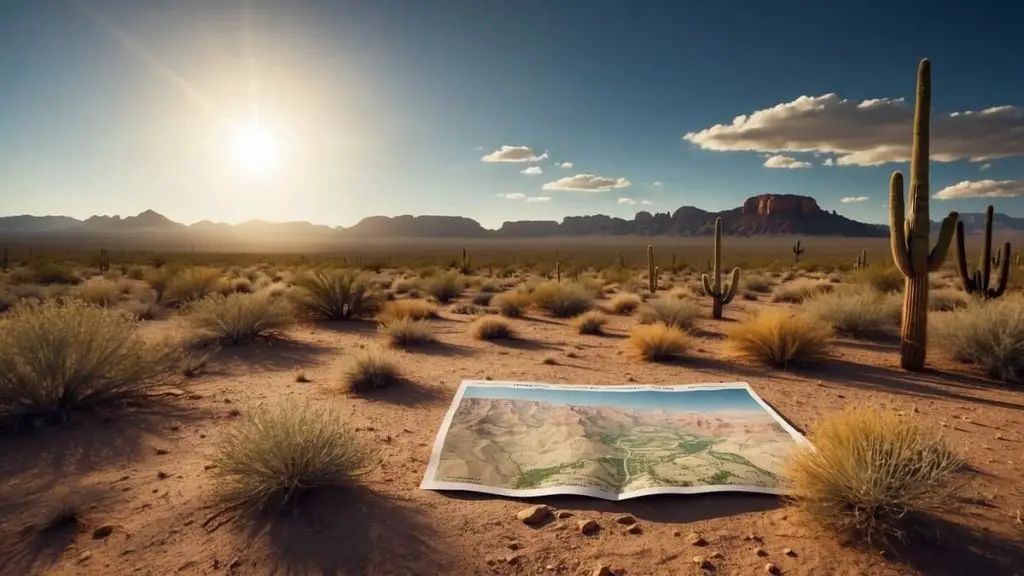
Conservation of the night sky is like taking care of any natural resource. You can help by using responsible lighting policies. Think of light as something that should only go where you need it. This keeps the night sky dark for everyone to enjoy.
- Use Shielded Lights: Make sure outdoor lights point down. This keeps the light on the ground, not in the sky.
- Choose Warm Lights: Lights that are too bright or bluish can light up the horizon more than needed. Warmer-color lights are better.
- Go for IDA-certified: Support places and products that are IDA-certified. They follow best practices for dark sky preservation.
Education is also crucial. Learning about why dark skies matter is something you can share with others. This way, more people can enjoy the beauty of the stars.
- Attend Workshops: Look for opportunities to learn about artificial light pollution.
- Spread the Word: Share what you learn with family and friends. The more people know the more change can happen.
The International Dark-Sky Association (IDA) offers help and information. They work with places that want to protect their night skies. With their support, we can all enjoy clear views of the cosmos.
Recreational Activities
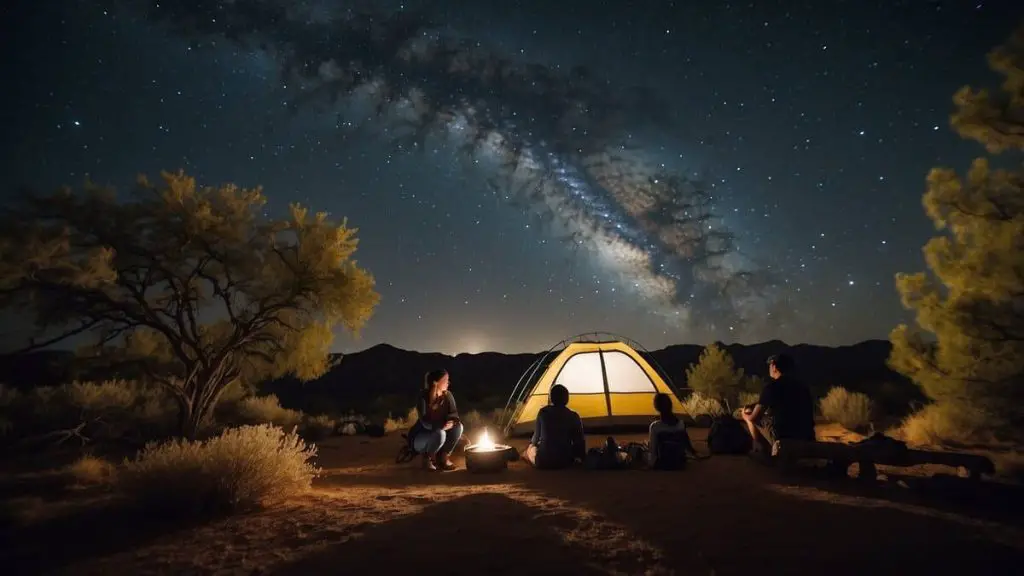
Arizona’s dark skies offer more than just a pretty view. You can do lots of fun things under the stars. That makes it perfect for lovers of the outdoors and the night sky.
Camping Under the Stars
During my camping trips in Arizona, I’ve found that pitching a tent gives you a front-row seat to the Milky Way. Many parks in Arizona allow overnight camping.
Here’s what you can expect:
- Crisp Night Air: Nothing beats fresh air when you camp out.
- Stunning Sky Views: Spot constellations and shooting stars before you sleep.
Hiking and Natural Explorations
During the day, take a hike and explore nature.
At night, the sky transforms:
- Diverse Trails: From easy walks to challenging terrains, you’ll find something suitable for you.
- Educational Programs: Some parks offer night walks to learn about stars and wildlife.
Astronomy-themed Lodgings
Stay at a place that loves stars as much as you do. The Arizona Sky Village is a great example:
- Telescopes in Rooms: Some lodgings provide telescopes for a closer look at the stars.
- Dark Sky Community: You’ll be around others who share your passion for astronomy.
Travel Planning for Dark Sky Destinations

When you’re looking to experience the beauty of the stars, planning a trip to a dark sky destination in Arizona is critical. Here’s what you need to know to make your adventure unforgettable.
Best Times to Visit
- Optimal Season: For the best stargazing experience, visit during the cooler months from September to April. The skies are clearer, and the weather is more comfortable for nighttime viewing.
- Moon Phases: Check the lunar calendar and aim for a new moon phase, as less moonlight means darker skies and better star visibility.
Accommodations and Stays
- Book Early: Dark sky areas are popular, so booking your stay in advance is wise to snag the best spots.
- Types of Stays: Choose from campgrounds, lodges, or hotels close to dark sky parks. Some places even offer special stargazing programs.
Travel Tips and Considerations
- Travel Light: Arizona’s dark sky spots can be remote. Pack what you need, but keep it light. A good flashlight and warm clothes are must-haves.
- Respect the Environment: These areas are remarkable. Help keep them dark by using red lights at night and staying on marked trails.
Remember, good planning means a better chance of an incredible starry sky experience!
Science and Research

Arizona’s dark skies are not just beautiful; they’re also crucial for critical science and research work. Here, I’ll give you the scoop on how Arizona helps us understand the stars.
Astronomical Discoveries and Research
In Arizona, astronomers look up to investigate the vast universe. They study stars, planets, and galaxies like Andromeda. These dark skies were crucial when Pluto was discovered.
Here’s what you should know:
- Dark skies: They let astronomers see celestial objects clearly.
- Big Finds: Discoveries like finding new details about faraway galaxies happen here.
Universities and Education
Universities in Arizona play a significant role. They teach students about space and research. One major player is the University of Arizona. Students and professors come together to learn about what’s up in the sky.
Here’s the lowdown:
- University of Arizona: A leader in space studies.
- Learning about space: Students here get hands-on with real space science.
Collaboration with Neighboring Regions
Arizona doesn’t stand alone. It works with places like New Mexico and the Four Corners region. They share skies, ideas, and research to help each other out. Collaborating means better science for everyone.
Remember this:
- Teaming up: Arizona and neighbors join forces for better star studies.
- Shared Knowledge: When they work together, they make significant strides in learning about space.
Photography and Observation

In this section, we’ll get into the best ways for you to capture the stars and find top spots for nighttime photography in Arizona. Ready your cameras and gaze up!
Astrophotography Techniques
Get to Know Your Gear: Before heading out, familiarize yourself with your camera’s manual mode. This is key for controlling exposure and focus at night.
- Use a tripod to keep your shots steady.
- A cable release or a timer can prevent a camera from shaking when you press the shutter.
Settings for the Stars:
- Set the focus to manual and adjust to infinity.
- Start with a wide aperture like f/2.8 to capture more light.
- Keep your ISO high enough to see the stars but not so high that the photo gets noisy. Think 1600 to 3200.
Dark Sky Photography Locations
Finding the Perfect Background:
- Look for places away from city lights for the darkest skies.
Because of their low light pollution, several Arizona locations are great for stargazing (Arizona Dark Sky Parks) and astrophotography.
Bucket-List Spots:
- Grand Canyon National Park: Imagine the Milky Way above the canyon!
- Sedona: Red rocks by day, brilliant stars by night.
Remember to respect the environment and check for any photography guidelines when visiting these locations. Happy shooting!
Local Culture and Heritage

Arizona’s dark skies connect you to a history as vast as the night sky. The cultural heritage here tells a story of celestial wonder and deep respect for astronomy that has endured for centuries.
Native American Sky Lore
In Arizona, the night sky is a canvas for the rich stories and traditions of Native American cultures. The stars have long guided their way of life, from navigation to agriculture:
- The Navajo see the cosmos as part of their cultural heritage, with constellations that teach moral lessons.
- The Hopi use the stars to decide the timing of ceremonies, ensuring their cultural practices align with the celestial calendar.
Historical Significance of Astronomy
The clear skies of Arizona have always been a natural observatory. Early settlers used the stars just as Native Americans did:
- Astronomy was crucial for navigation and understanding the seasons for planting and harvesting.
- Historic sites across the state reflect this, with many old observatories contributing to our knowledge of the sky.
By looking up at the Arizona dark sky, you connect with a cultural and historical legacy that shines as bright as the stars above.
Frequently Asked Questions
How do I identify constellations and planets in Arizona’s dark skies?
To identify constellations and planets in Arizona’s dark skies, familiarize yourself with familiar constellations and use a star chart or an astronomy app. These tools will help you pinpoint celestial objects and enhance your stargazing experience.
What are the best times of year for stargazing in Arizona?
The best times of year for stargazing in Arizona are during the cooler months, from September to April. During this period, the skies are typically clearer and offer optimal conditions for observing stars and other celestial objects.
Can I participate in any astronomy-related community activities in Arizona?
Yes, you can participate in astronomy-related community activities in Arizona. Local astronomy clubs and observatories host star parties, public stargazing events, and educational workshops. These events are great opportunities to learn about astronomy and meet fellow enthusiasts.
TL;DR
- Arizona offers exceptional dark sky locations, like Grand Canyon and Oracle State Park, ideal for stargazing and experiencing the night sky in its natural state.
- Dark Sky Parks and Communities in Arizona, such as Flagstaff and Sedona, are committed to preserving dark skies through smart lighting and public outreach.
- The benefits of dark skies in Arizona include enhanced stargazing, healthier ecosystems, energy savings, educational opportunities, and the enjoyment of natural beauty.
- Resources like Bortle Scale maps, star charts, and astronomy apps are available to help you identify celestial objects and plan your stargazing sessions.
- Arizona hosts various astronomy-related activities, including star parties and educational events at observatories and astronomy clubs, providing community engagement and learning opportunities.
I’m always eager to share my passion for the night sky and learn from others’ experiences. I’d love to hear from you if you have any questions or want to share your stargazing stories.
Please feel free to leave a comment or ask a question below – let’s keep the conversation sparkling like the stars!



